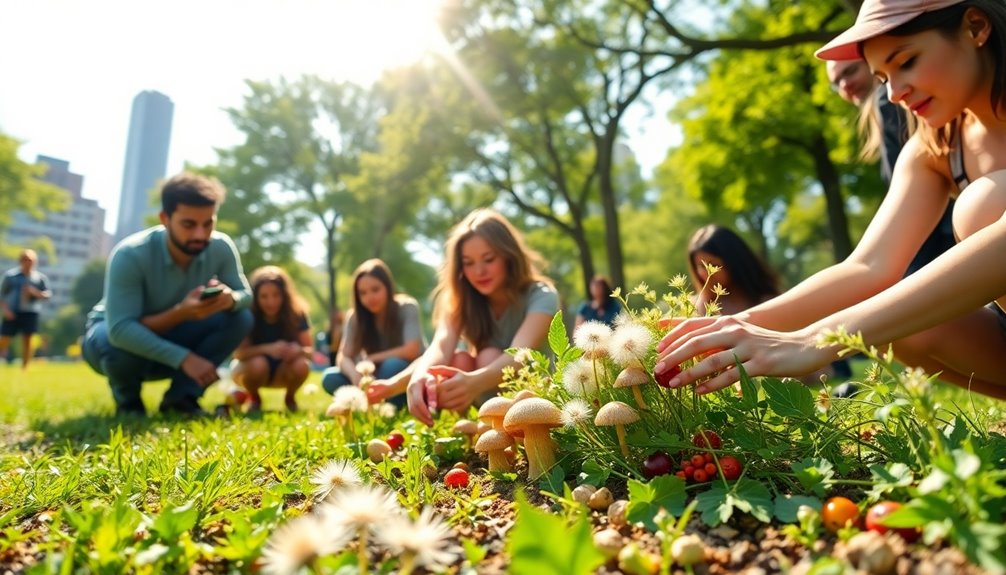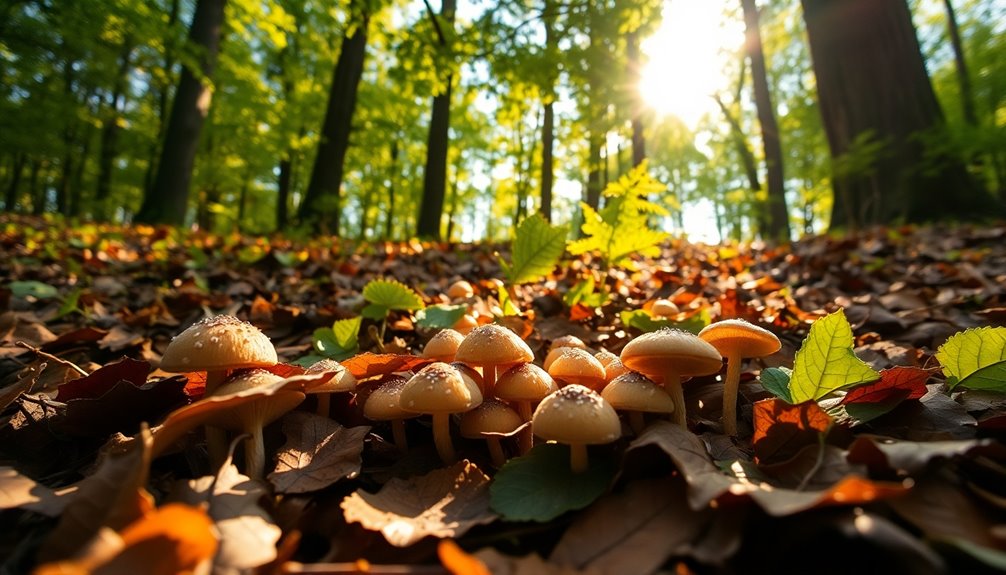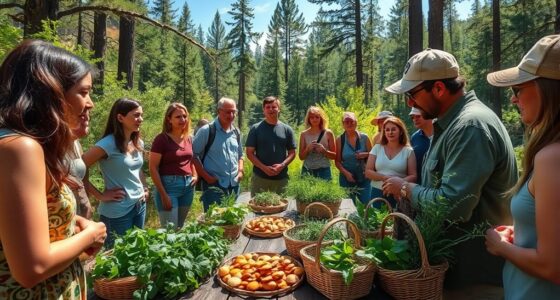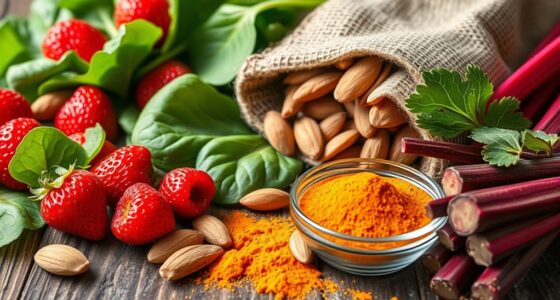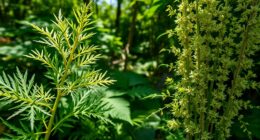You can forage in some city parks, but it's important to know the local laws first. Regulations differ widely; while some parks are open to foraging, others prohibit it entirely, creating loopholes. Urban foodies often take advantage of these gray areas to enjoy wild edibles, like dandelions and wild mint. However, you should always forage ethically and sustainably, ensuring you respect local ecosystems. Understanding your area's specific rules can keep you in the clear. Curious about how to navigate these laws and find the best foraged foods? There's plenty more to explore in this fascinating topic!
Key Takeaways
- Many city parks prohibit foraging, but some urban foodies exploit ambiguous regulations or loopholes, relying on unclear local laws.
- Certain states may allow foraging in city parks with few restrictions, offering opportunities for free food amid urban landscapes.
- Urban foragers often target less monitored areas or parks with minimal enforcement, circumventing strict regulations on public land.
- Advocates argue for clearer foraging laws, promoting responsible practices that support biodiversity while allowing urban foraging.
- Ethical foraging practices, like harvesting sustainably and respecting local ecosystems, are essential to mitigate potential ecological impact in city parks.
Understanding Urban Foraging

Urban foraging is an exciting way to discover wild edible plants right in your city. It allows you to explore public parks and hidden green spaces, connecting you with nature amid the hustle and bustle of urban life.
As you venture out, you'll find a variety of edible plants, including dandelions, chickweed, and purslane. These plants not only offer nutritional benefits but also boast medicinal properties that can enhance your well-being.
Each season brings new foraging opportunities. In spring, you can harvest leafy greens and delicate flowers, while summer offers an abundance of fruits and berries.
By foraging, you can access free, nutritious food options that reduce waste and foster a deeper connection with your local ecosystem.
However, safety is essential in urban foraging. Always practice accurate plant identification to avoid potential hazards.
Be aware of urban pollutants that may contaminate the plants you find. By being informed and cautious, you can enjoy the rewards of urban foraging while contributing to environmental sustainability.
Legal Framework for Foraging
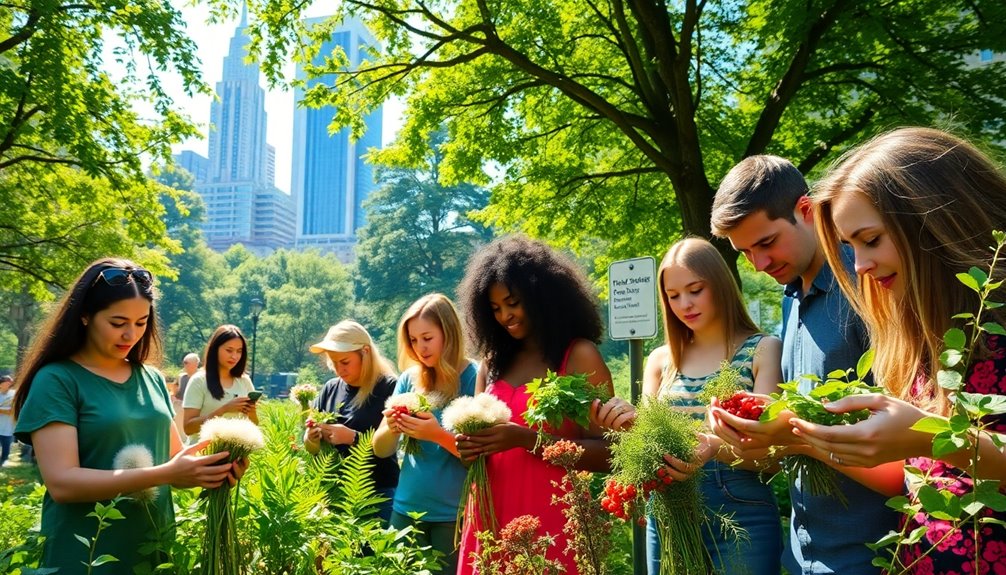
When you think about foraging in city parks, it's essential to understand the legal framework governing these activities.
Regulations can vary considerably from one state to another, and even among urban parks, some impose strict restrictions while others may allow limited foraging.
Knowing the specific rules and permitted practices in your area will help you forage responsibly and legally.
State-Specific Regulations Overview
Maneuvering the maze of foraging regulations can be perplexing, as laws vary considerably from state to state and even within local jurisdictions. Some states, like California and Arkansas, impose strict bans on foraging in state-owned lands, while Alaska and Hawaii generally permit it. In New York City, foraging in public parks is completely banned, with fines waiting for those who harvest common plants without permission.
| State | Foraging Status |
|---|---|
| California | Strict ban in state parks |
| Alaska | Generally permitted |
| New York City | Complete ban in city parks |
The National Park Service also prohibits disturbing plants in national parks, although limited foraging may be allowed on a case-by-case basis. Some states have specific regulations regarding the types, methods, and quantities of foraged items. This creates a complex legal framework that often leaves foragers confused and unaware of potential legal issues. Many visitors only learn about the foraging regulations after unintentionally violating them, emphasizing the urgent need for clearer communication of local laws to help avoid park avoidance.
Urban Park Restrictions
Foragers face a complex web of restrictions in city parks that can make harvesting wild edibles a risky endeavor. Urban foraging isn't as straightforward as you might think; many cities, like New York, enforce a complete ban on foraging in public parks, with violators facing hefty fines.
It's vital to keep in mind that park rules can vary considerably depending on the location. While some states, like Alaska and Hawaii, generally permit foraging practices, others, including Arkansas and California, strictly prohibit it on state-owned lands.
The National Park Service also has a blanket prohibition against removing or disturbing plants in all National Parks, although specific conditions might allow limited foraging.
This inconsistency creates confusion, often leaving newcomers unaware of the strict regulations until they've broken them. To avoid legal troubles, you must research the specific park regulations before attempting to forage. Local jurisdictions may impose additional restrictions, so it's important to stay informed.
In many regions, understanding the ethical foraging practices is key to responsibly enjoying the bounty of wild edibles without running afoul of the law.
Permitted Foraging Practices
Steering through the legal landscape of foraging can be intimidating, but understanding permitted practices is essential for anyone interested in harvesting wild edibles. Foraging regulations vary widely, so you need to familiarize yourself with local laws before you start.
In places like New York City, foraging in parks is completely banned, while states like Alaska and Hawaii generally allow it. Individuals with borderline personality disorder may exhibit impulsive behaviors that can complicate interactions in community settings, including foraging. Maintaining emotional alignment can help ensure a more positive experience while foraging in groups. Those with BPD may also benefit from mindfulness techniques to enhance their emotional regulation during such activities. Additionally, understanding the seasonal growth patterns of edible plants can significantly improve your foraging success.
The National Park Service prohibits the removal of plants in national parks, but park superintendents can grant limited foraging permissions under specific conditions. Meanwhile, states like Arkansas and California impose strict bans on foraging in state-owned lands.
Confusion often surrounds these rules, and many people only learn about them after inadvertently breaking them, which can have implications for public health and the environment.
To forage legally and sustainably, you'll want to pay attention to regulations that dictate the type, method, and quantity of edible weeds you can harvest. Understanding investment regulations can also be crucial, as it helps to navigate financial aspects that might arise from foraging-related activities.
Common Misconceptions
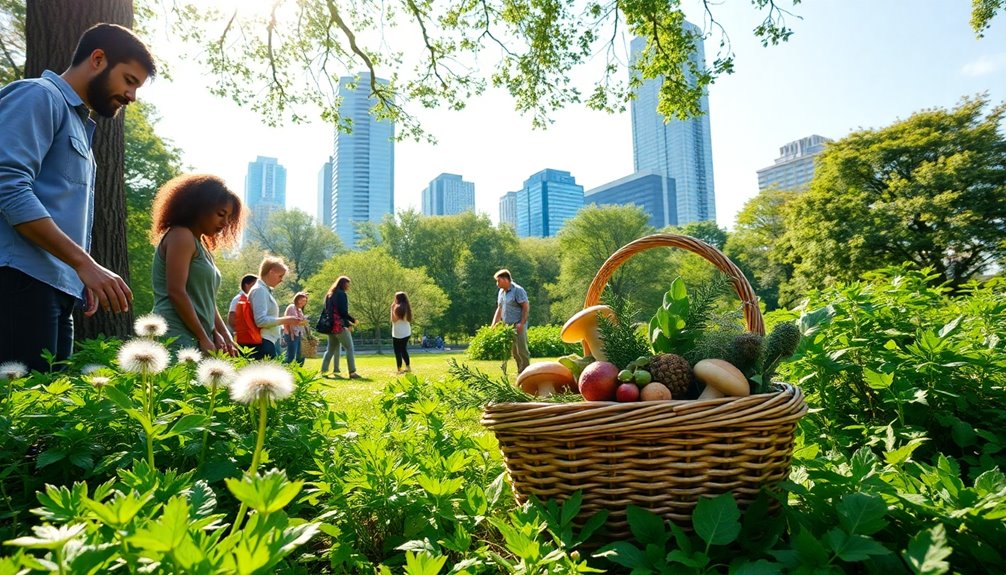
Many people assume that foraging in city parks is a free-for-all, but this couldn't be further from the truth. Many urban areas, including cities like New York, enforce strict bans on foraging, which can lead to fines for picking common plants or fungi.
The idea that you can forage freely stems from common misconceptions about public spaces. Regulations vary widely by location, and in some areas, foraging is only allowed in designated spots or under specific conditions.
Even the National Park Service prohibits foraging in all national parks, emphasizing that removing or disturbing plants is against federal regulations. This creates confusion for many who think they can forage wherever they please.
There's also a misunderstanding regarding community gardens; some foragers believe they can pick without permission, but these spaces often have their own rules that require prior approval from garden management.
Without a clear understanding of local laws and restrictions, you might find yourself facing unwelcome consequences. It's crucial to research your area's regulations before you head out to forage, ensuring your urban foraging experience is both enjoyable and legal. Additionally, understanding the potential impact of foraging on local ecosystems is vital for responsible foraging practices and safeguarding seniors' finances.
Environmental Impacts
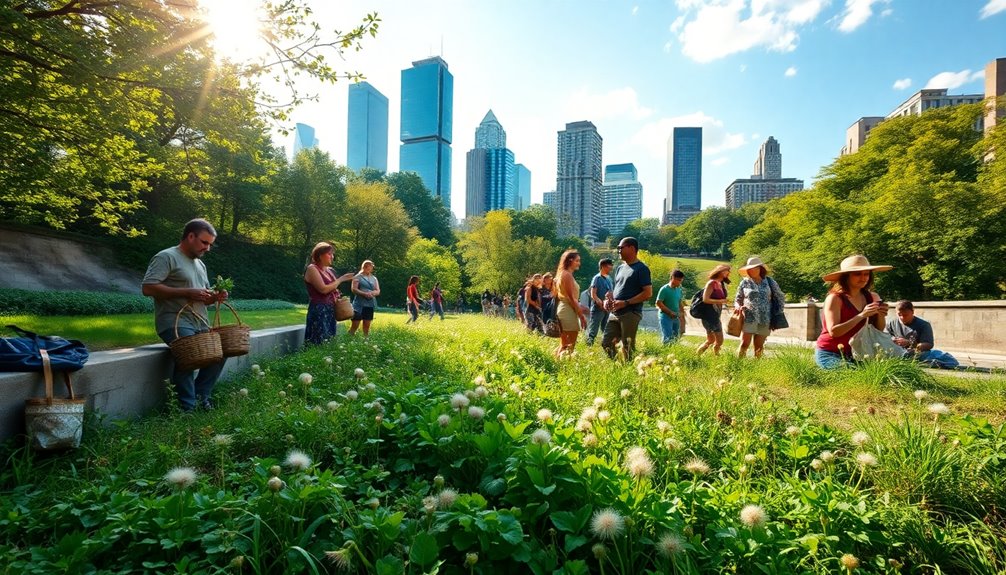
When you forage in city parks, it's crucial to reflect on how your actions can disrupt the ecological balance and threaten local biodiversity.
Overharvesting can diminish plant populations and negatively impact wildlife habitats.
Practicing sustainable foraging methods helps protect these ecosystems and guarantees that they thrive for future generations. Additionally, understanding the importance of biodiversity conservation can enhance your foraging practices by ensuring that you do not adversely affect local wildlife.
Ecological Balance Disruption
Urban foraging, while appealing for its connection to nature, can disrupt ecological balance in city parks. When you harvest wild plants without care, you risk overharvesting, which leads to a decline in local species. This not only affects the plants but also the local wildlife that relies on them for food and shelter. Unsustainable foraging practices can degrade soil and hinder the regeneration of essential flora. Additionally, environmental consequences such as habitat destruction can arise from irresponsible foraging habits.
Here's a quick look at the impacts:
| Impact Type | Description |
|---|---|
| Overharvesting | Reduces local plant species |
| Soil Degradation | Affects the health of the ecosystem |
| Competition | Non-native species compete with native plants |
| Wildlife Disruption | Disturbs feeding and breeding patterns |
| Responsible Foraging | Key to maintaining ecological balance |
Biodiversity Loss Risks
Foraging in city parks can pose significant risks to biodiversity, particularly through the threat of overharvesting. When you pick too many plants, you disrupt local ecosystems and threaten the survival of native species. This removal can lead to a decrease in habitat availability for wildlife, affecting the intricate food webs that sustain urban environments.
Urban foraging already faces challenges like habitat fragmentation and pollution, making responsible foraging practices even more vital. If you take only a small percentage of a plant population, you help guarantee that species can regenerate and maintain their presence in these areas. However, many urban foragers may not realize the impact of their actions.
Education on responsible foraging practices is essential. By understanding the importance of biodiversity, you can foster a sense of stewardship that encourages you to protect local plant and animal species.
When you engage in urban foraging, consider the ecological implications of your choices. The survival of native species—and the health of urban ecosystems—depends on your actions and commitment to sustainable practices.
#
Sustainable Foraging Practices
Sustainable foraging practices play an important role in maintaining the health of urban ecosystems. By taking only what you need, you allow plants to regenerate, guaranteeing that ecosystems remain balanced and healthy. This approach is essential for preserving biodiversity in city parks and other urban environments. Overharvesting can threaten local ecosystems, making responsible foraging practices critical for protecting vulnerable species. Incorporating natural resource management strategies can further enhance the sustainability of urban foraging efforts.
Using responsible harvesting techniques, like taking no more than one-third of a plant, helps promote its survival and sustains the recreational activity of foraging. Additionally, understanding the importance of basket weaving techniques can enhance your foraging experience by ensuring you carry your harvest sustainably. Research indicates that engaging in early exposure to STEM can enhance children's understanding of local ecosystems and their roles. By engaging in sustainable foraging, you not only promote environmental stewardship but also gain a deeper understanding of local ecosystems and the importance of conserving natural resources. Furthermore, understanding the impact of over-foraging on ecosystems allows for more informed decisions that benefit both foragers and the environment. Recognizing the role of cash flow management can also support foragers in establishing sustainable practices that do not exploit local resources.
Adhering to ethical foraging guidelines allows you to minimize your ecological impact while supporting efforts to maintain biodiversity and ecosystem health. As you forage, consider the long-term effects of your actions on the environment.
Sustainable practices guarantee that future generations can enjoy the same natural resources you do today. Ultimately, making thoughtful choices while foraging can contribute considerably to the well-being of urban ecosystems, fostering a harmonious relationship between people and nature.
Safety Considerations
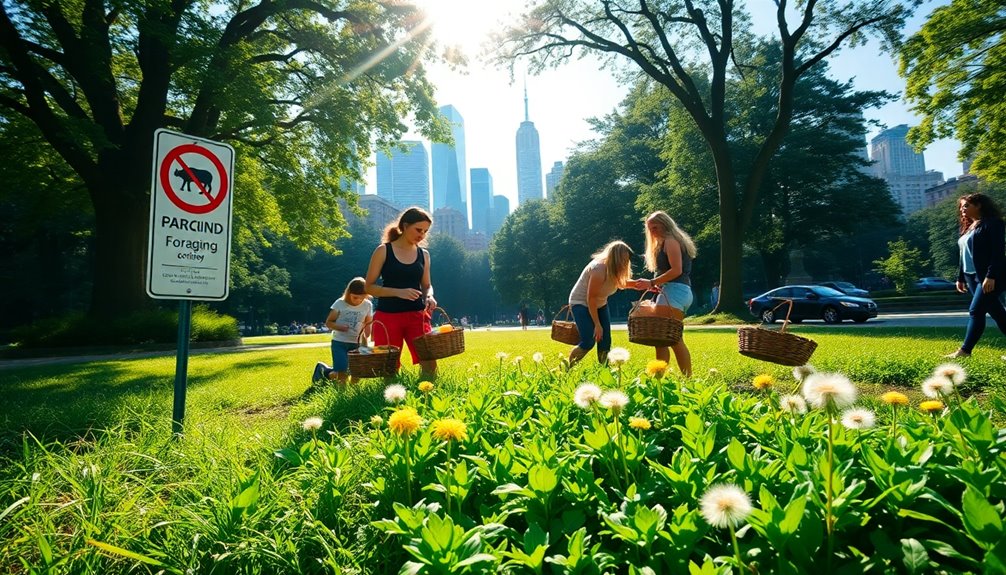
Safety considerations are essential when you're foraging in city parks. You'll face safety risks primarily from contaminants like pollutants and pesticides. To minimize these risks, avoid foraging near roadsides, industrial sites, and other hazardous areas.
Washing all foraged items thoroughly is vital; contaminants often cling to soil or dust and can be ingested even if the plants themselves aren't directly affected.
Knowledge of local toxic plants is another important aspect of foraging. Familiarize yourself with both edible plants and their toxic counterparts to steer clear of potential health hazards.
While urban foraged fruits are generally considered safer due to their lower heavy metal content, vegetables can absorb more contaminants from the soil.
To reduce health risks, aim to forage in lower traffic areas and keep a safe distance from potential contamination sources. While specific guidelines on distance can vary, erring on the side of caution is wise.
## Sustainable Foraging Practices
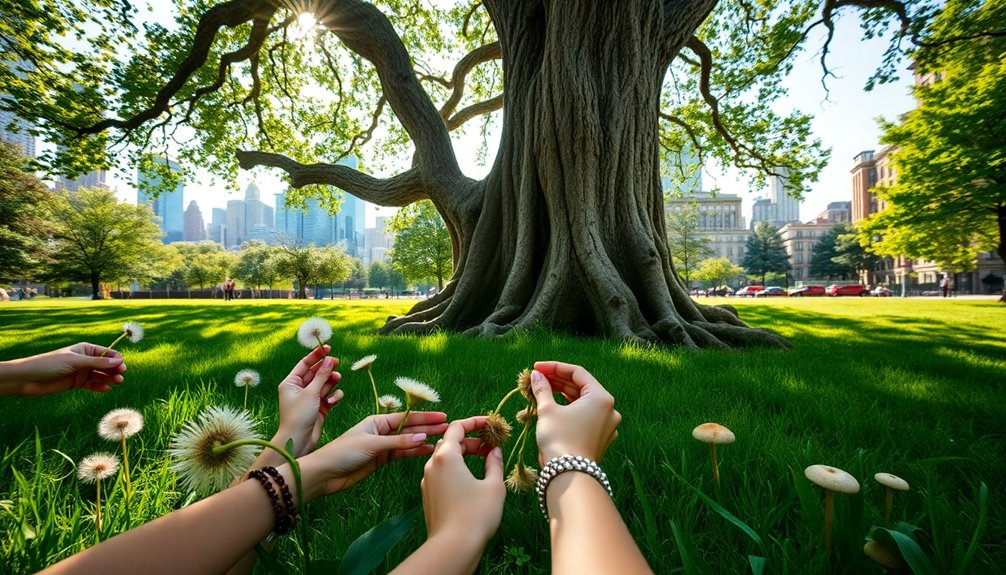
Mindful harvesting is key to enjoying the bounty of city parks while preserving their natural beauty. To practice sustainable foraging, you should only take what you need, allowing plants to regenerate and keeping local ecosystems balanced. A good rule of thumb is to harvest no more than one-third of a plant. This approach promotes biodiversity and supports the survival of the species you're foraging.
When foraging, always prioritize areas away from potential contaminants like industrial sites and busy roads. This helps minimize the health risks associated with pollution, ensuring the safety of the food you collect.
Engaging in ethical foraging practices, including following Leave No Trace principles, not only protects the environment but also guarantees that these resources remain for future generations. Additionally, understanding the importance of local ecosystems can enhance your foraging experience by ensuring you respect the natural balance of the area.
Educating yourself and others about sustainable foraging practices can create a deeper connection to local ecosystems. By fostering community awareness, you'll encourage stewardship among urban foodies and inspire a collective effort toward conservation.
Foraged Foods and Recipes
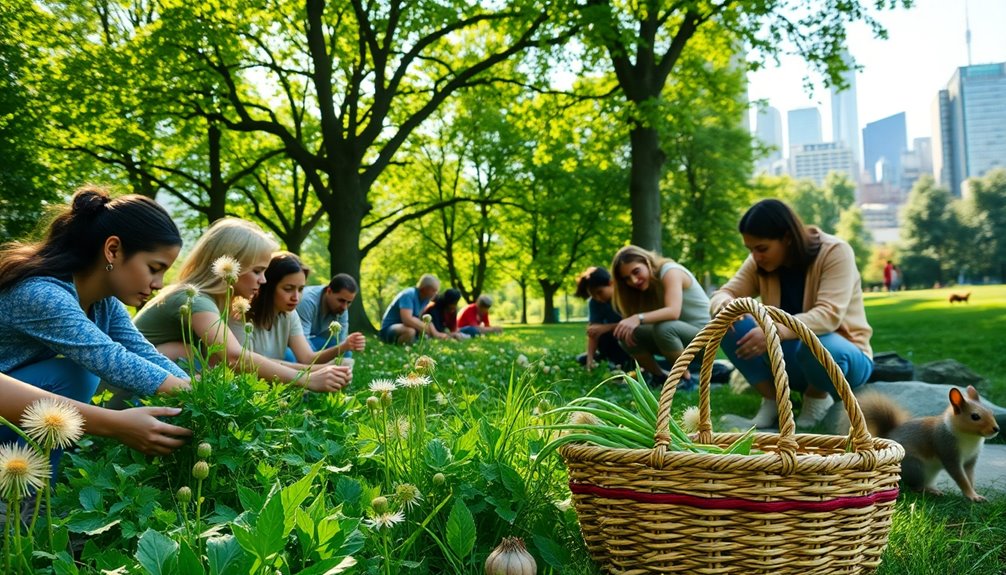
When you forage in city parks, you can discover a wealth of seasonal ingredients that add unique flavors to your meals. From dandelion greens in a fresh salad to wild strawberries in a delightful dessert, the culinary possibilities are endless. Moreover, foraging can be a sustainable way to reduce overall energy consumption while enjoying fresh, organic produce. Additionally, many foraged items, such as wild herbs, are known for their high levels of antioxidants, showcasing the health benefits of incorporating these ingredients into your diet. Incorporating adaptogenic herbs found in urban foraging can also enhance your overall wellness. Interestingly, foraged foods can also be high in fiber, contributing to better digestive health. Furthermore, many foraged foods can be rich in beta-glucans, which support immune system function. Let's explore some simple recipes that showcase the versatility of these foraged treasures.
Seasonal Foraged Ingredients
Foraging in city parks offers a delightful way to connect with nature while discovering seasonal ingredients that enhance your culinary creations. Each season reveals distinct seasonal foraging opportunities, from leafy greens and flowers in spring to fruits and berries in summer.
You can find common foraged ingredients like dandelion greens, perfect for salads or sautéing, and wild mint, which adds a revitalizing twist to your iced teas. Raisins can cause acute kidney failure in dogs, so be cautious about what you share with your furry friends when foraging. Additionally, engaging with nature through foraging can contribute to emotional well-being, similar to the benefits of pet therapy for individuals with dementia or Parkinson's.
As autumn rolls in, you'll spot black walnuts, a favorite for baking due to their rich flavor, alongside root vegetables waiting to be unearthed.
In winter, hardy greens and evergreen needles provide unique flavors and nutrients. Remember, foraging in National Parks can be particularly rewarding, but be mindful of local regulations.
With every season, awareness of local flora changes is vital, as availability can vary. You might enjoy elderberries in late summer for syrups and jellies, or explore the vibrant world of garlic mustard for dips.
Additionally, understanding Leave No Trace principles is essential to ensure that foraging does not harm the environment. Embrace the challenges of foraging, and you'll enhance your meals with fresh, edible plants right from your local parks, making each dish a celebration of the season.
Creative Culinary Uses
Exploring the culinary potential of foraged ingredients opens up a world of creativity in your kitchen. Foraged foods are not just a sustainable choice; they bring unique flavors and health benefits to your meals. Imagine incorporating wild greens like dandelion into your next dish. You can use them in salads or sauté them for a nutritious side.
Here are some culinary applications to inspire you:
| Foraged Food | Creative Use |
|---|---|
| Dandelion Greens | Pesto or sautéed as a side |
| Wild Strawberries | Desserts or fresh snacks |
| Black Walnuts | Baked goods or nutritious snacks |
You might also experiment with garlic mustard for dips or plantain in fresh salads. Don't forget about foraged herbs like wild mint, which can elevate iced teas and salad dressings. By utilizing these plants growing in your local parks, you're not only enjoying delicious meals but also promoting the use of locally sourced ingredients. Embrace the adventure of foraging and let your creativity flow in the kitchen!
Simple Foraging Recipes
With a little creativity and a keen eye, you can turn your foraged finds into simple yet delicious meals. If you've taken a foraging class, you know that foraging involves discovering wild plants like dandelion greens and lambsquarters.
These vibrant greens can elevate your salads or be sautéed with garlic for a nutritious side dish. For a revitalizing summer treat, try infusing wild mint into your iced creams or salad dressings. It brings a delightful flavor that'll impress your guests.
Don't forget about foraged fruits like wild strawberries and raspberries, which are perfect for snacking or making quick desserts. In the autumn, gather black walnuts for a unique twist in baked goods or enjoy them as a healthy snack.
You can even create a tasty pesto using dandelion greens or whip up a dip with garlic mustard. These simple foraging recipes showcase the versatility of your finds and prove that cooking with nature's bounty can be both easy and rewarding.
Community Engagement

Community engagement plays an essential role in fostering a vibrant culture of urban foraging. By participating in community initiatives like Beacon Food Forest, you can connect with others who share your passion for foraging.
These spaces not only provide foraging opportunities but also serve as educational hubs where you can learn about local flora and wild edibles. Local foraging groups often organize workshops that offer hands-on experiences, helping you identify edible plants and practice sustainable foraging techniques.
Engaging with others in these settings can deepen your understanding of the ecosystem and promote responsible foraging practices.
Additionally, online platforms and apps like VILD MAD make it easy to connect with fellow foragers, enabling you to share knowledge and coordinate group activities.
This collaborative spirit fosters a sense of stewardship for local ecosystems, encouraging you to respect and protect the natural resources you utilize.
Resources for Urban Foragers

Urban foragers have a wealth of resources at their fingertips to enhance their foraging adventures.
By tapping into these tools, you can deepen your understanding of local edible plants and improve your foraging skills.
Here are some valuable resources you can explore:
- Mobile Apps: Use apps like VILD MAD to identify local wild edibles and connect with fellow foragers.
- Community Workshops: Join local organizations offering hands-on foraging workshops to learn about sustainable harvesting and plant identification.
- Foraging Groups: Participate in local foraging groups that share information on city regulations and safe foraging practices.
- Books and Guides: Invest in books focused on urban foraging to gain insights into seasonal availability and uses of edible plants.
- Local Markets: Engage with community gardens and markets to share foraged goods and knowledge, fostering collaboration among urban foragers.
Advocacy for Foraging Rights
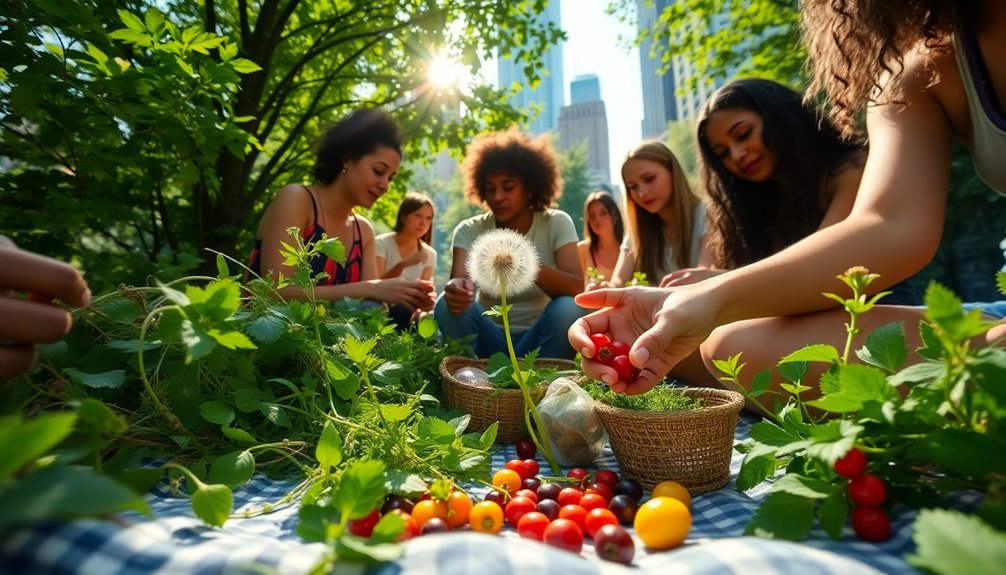
Foragers often face a patchwork of regulations that can make gathering food in city parks a tricky endeavor. The advocacy for foraging rights emphasizes the need for clearer rules, as laws vary dramatically from one jurisdiction to another. In cities like New York, strict bans on foraging in public parks discourage many from engaging with their surroundings.
However, community initiatives are pushing back. These efforts promote legal foraging as a means of fostering community engagement and ecological stewardship. Experts argue that allowing foraging in urban settings not only enhances public connection to nature but also nurtures a sense of responsibility for local ecosystems, aligning with broader conservation goals.
The National Park Service (NPS) has been urged to adopt a default position that permits foraging, which would necessitate Congressional action for significant legal changes.
By advocating for these rights, you can help create a more inclusive environment where foraging is seen as a sustainable practice rather than a legal gray area. Educational workshops and local initiatives are key in raising awareness and promoting responsible practices that respect both regulations and biodiversity.
Through these efforts, we can cultivate a culture that embraces foraging in our urban landscapes.
Frequently Asked Questions
Can You Forage in a City Park?
You can forage in a city park, but it really depends on local regulations.
Some parks have strict rules against foraging, while others might allow it under certain conditions.
It's important to check the specific laws in your area before you start gathering plants.
If you're unsure, look for community classes or programs that promote responsible foraging.
Always remember to respect nature and only take what you need to keep ecosystems balanced.
Is It Illegal to Forage in Parks?
You might think of foraging in parks like finding hidden treasure, but it can be a risky adventure.
In many cities, it's illegal to pick plants, and parks often have strict rules against foraging. For instance, New York City imposes heavy fines for such activities.
Even if you see something tasty, it's best to check local regulations first. Ignorance of the law won't keep you safe from penalties, so always tread carefully.
Is It Legal to Forage in Prospect Park?
No, it isn't legal to forage in Prospect Park.
New York City parks enforce strict regulations that ban the removal of plants to protect local ecosystems. If you pick or disturb plants, you could face fines.
It's essential to understand these rules before considering foraging. While some enthusiasts might ignore them, the legal risks can deter you from enjoying this activity in urban settings like Prospect Park.
Always check local laws first!
Is It Safe to Forage in the City?
Foraging in the city can be risky, but it's not impossible. You need to stay aware of potential contaminants from pollutants and pesticides, so avoid areas near roads and industrial sites.
Always wash what you collect thoroughly to reduce contamination risk. It's essential to know local plants to distinguish between edible and toxic varieties.
Plus, check local regulations, as some areas might prohibit foraging, and you don't want to face fines for unauthorized harvesting.
Conclusion
Urban foraging opens a world of culinary adventure right in your backyard, but it's essential to tread carefully. By understanding the legalities and potential environmental impacts, you can enjoy the bounty of city parks without fear. So grab your basket and plunge into this deliciously rebellious movement! Remember, each bite of foraged food could feel like a mini revolution on your plate, sparking a connection to nature that's nothing short of extraordinary. Happy foraging!

